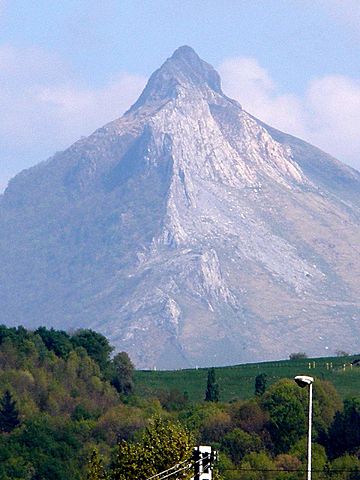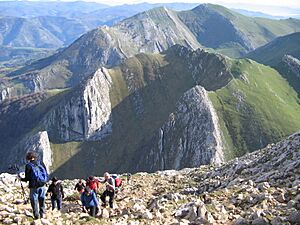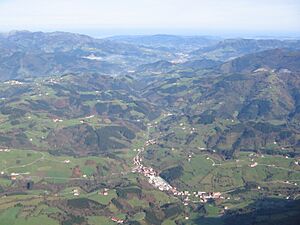Txindoki facts for kids
Quick facts for kids Txindoki |
|
|---|---|

Txindoki from Beasain
|
|
| Highest point | |
| Elevation | 1,346 m (4,416 ft) |
| Naming | |
| Language of name | Basque |
| Pronunciation | Basque: [tʃinˈdoki] |
| Geography | |
| Location | Gipuzkoa, Spain |
| Parent range | Basque mountains, Aralar |
| Climbing | |
| Easiest route | From Larraitz in Abaltzisketa |
Txindoki is a famous mountain in the Basque Country, Spain. It is 1,346 meters (about 4,416 feet) tall. People also call it Larrunarri. The mountain got its popular name, Txindoki, from some shepherd huts nearby. Because of its pointy shape, some people even call it the Basque Matterhorn.
Txindoki is the most western part of the Aralar mountain range. Its unique shape makes it a symbol for the whole Goierri valley. The mountain stands tall above the town of Amezketa and its farms. Most of this side of the Aralar mountains does not have many trees. The northern side of Txindoki has steep slopes and a wild valley called Muitze. A rocky ridge made of limestone runs across the mountain's top. This ridge is popular for rock climbing.
Contents
Exploring Txindoki: Trails and Paths
Main Path for Hikers
The most popular way to reach Txindoki's top starts from a place called Larraitz. Larraitz is about 403 meters (1,322 feet) high. You can get there by car from Alegia or Ordizia in about 15 minutes.
Larraitz has a large picnic area and a car park called Zamao. There are also a few restaurants, which used to be farmhouses, and an old church from the 1600s. All of this is surrounded by nice green fields.
From the south end of Larraitz, a wide dirt path goes southwest. Soon, you will see a fork in the path. Take the left path to go towards Txindoki. This wide path soon turns into a smaller trail. It then goes east at the bottom of the mountain ridge.
The trail continues across the southern side of the mountain. You will walk past a pine tree forest on your right. After about an hour of walking, you will reach the Oria spring. From there, the path goes up steeply in zigzags. You will then reach the Zirigarate huts, which are in a small dip.
From Zirigarate, the trail goes east to a pass called Egurral, which is 1,152 meters (3,780 feet) high. This is the last stop before the final climb to the top. The ground here is mostly rocky karst terrain. On sunny days, especially in spring and summer, many people hike to the top. From the peak, you can see amazing views of Gipuzkoa and the Aralar Range on a clear day. The top of the mountain has small memorials and a postbox for hikers.
If you want a harder challenge, you can take a different path from the Oria spring. This path goes east up a tough grassy slope. It also leads to the Egurral pass.
The Wild Muitze Valley Route
Another way to climb Txindoki is through the wild Muitze valley on the north side. Not many hikers know about this route. You start from Larraitz on the same path as the main route. After a few minutes, you will pass a winding slope. Look for a marker called Gazteraztegi, which is at 520 meters (1,706 feet).
Here, a wide path goes in the opposite direction, leading up to an antenna at Urtzabal goikoa, 610 meters (2,001 feet) high. You can also take a shortcut from Larraitz that goes straight up to the antenna. This way is faster but harder.
Just before the final climb to the antenna, a narrow path goes southeast into the steep valley of the Muitze stream. You will see waterfalls along the way. The trail leaves the forest and crosses the stream where the trees end and grasslands begin. After climbing over some rocks, you need to cross the stream again. A path on the steep slopes to the right leads to the Txindoki hut and an orchard. This orchard gave the mountain its current name.
Legend says that the mythological goddess Mari lives in a crack in the rock near this place, called Marizulo. By following this steep path, you will reach the Egurral pass in about 1 hour and 45 minutes.
Special Events at Txindoki
Cattle Migration Day
Every year on May 1st, a special event takes place in Larraitz. Farmers gather their cattle, like sheep, horses, and cows, to move them to the high grasslands of Aralar. They stay there until October. This day is a happy celebration with many people, traditional Basque music called trikitixa, and stalls selling local products. You can find things like cider and cheese, as well as handmade crafts. In 2008, about 18,000 sheep, 650 mares (female horses), and 700 cows were expected to make this journey.
Saint Peter's Day Celebration
On June 29th, which is Saint Peter's Day, a big and popular religious celebration happens at the hermitage (the old church) in Larraitz. This gathering is called an erromeria in the Basque language.
See also
 In Spanish: Txindoki para niños
In Spanish: Txindoki para niños



